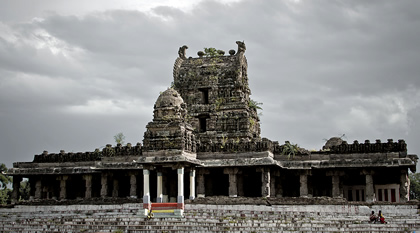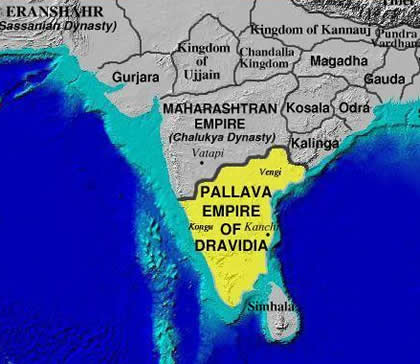World History
Pallava was a state based in Southeast India that flourished between approximately the fourth and the ninth centuries c.e. The Pallava dynasty was Hindu but also supported Buddhism and Brahmanism and was known as a patron of the arts. Under its rule, trade grew with Sri Lanka and with Southeast Asia and the state appears, so far as can be determined, to have been quite prosperous.
It established its capital at Kanchi, close to modern Chennai (previously known as Madras). Tamil influences and cultural institutions grew in importance throughout the course of the Pallava dynasty and continued with its Chola successors.
Various theories have been put forward for both the origin and the demise of the Pallava state. The Pallava people may have been a part of the Parthians, the Dravidians, the Cholas, or several other distinct ethnic groups.
It is most likely that the majority of the people were a mixture of different ethnic groups interacting together within a common territory. Migration was a notable feature of the ancient world and even if social mobility was rendered very difficult by the caste system, geographical mobility was often possible on either an individual or a group basis.
The first named Pallava ruler was King Visnugopa, who appears in local records in the common Prakrit version of Sanskrit. Other kings and rulers appear in subsequent records but few meaningful details are available beyond their names. The lives of ordinary people can only be reconstructed from archaeological excavation.
Pallava rulers appear to have expanded their territories in the early centuries of their existence, but it is possible that this expansion was the discovery of other peoples involved in similar cultural practices and not the result of conquest at all. However, territorial expansion ended and subsequent Pallava rulers were persistently harried by the Chola feudatory allies of the Calukya dynasty to the west.
Chola rulers gradually supplanted Pallava influence throughout its territory and gradually brought its rule to an end. It is difficult to determine whether this change of rulership made any real difference to the lives of the mass of the common people.
The sculptures and inscriptions of the Pallava state are notable in the development of the Indian artistic tradition. One of the centerpieces of this architecture may be found at the Shore Temple located at Mahabalipuram.
This combines Dravidian styles with other influences and was formerly a port. Ports are notable for the ways in which cultural institutions of various ethnicities interact and interrelate, sometimes creating entirely new combinations.
- Burma
Burma The classical civilization of Burma (Myanmar) is centered at Pagan. After the collapse of the Pyu state, the Mrammas (Sanskritized Brahma), or Burmans, founded their chief city, Pagan (Arimarddanapura or “City Where Enemies Were Exterminatedâ€)...
- Chenla
Chenla army Two successive kingdoms with strong Indian influence emerged during the pre-Angkorean centuries of Khmer history. These were the Funan, from the second to sixth centuries, and Kambuja (Chenla, Zhenla in Chinese) from the sixth to the eighth...
- Harsha Vardhana - Indian King
Harsha kingdom map Harsha Vardhana was a king of northern India who reunited some of the small city-states that had become independent after the fall of the Gupta dynasty and who used his position to reinvigorate the practice of Buddhism throughout his...
- Tamil Culture
Tamil Culture Tamil is a Dravidian language group that originated in southern India and is not linked to the northern Aryan language group. Tamil speakers are found in Tamilnadu, the region surrounded by Kerela, Karnataka, and Pradesh and parts of present-day...
- History Of Burma
History of Burma. This is a good general overview to the history of the Asian nation of Burma. I realize that the legal name of the country is now Myanmar but who the heck calls it that? From the site: Burma was unified by Burman dynasties three...
World History
Pallava Kingdom
 |
| Pallava Kingdom |
Pallava was a state based in Southeast India that flourished between approximately the fourth and the ninth centuries c.e. The Pallava dynasty was Hindu but also supported Buddhism and Brahmanism and was known as a patron of the arts. Under its rule, trade grew with Sri Lanka and with Southeast Asia and the state appears, so far as can be determined, to have been quite prosperous.
It established its capital at Kanchi, close to modern Chennai (previously known as Madras). Tamil influences and cultural institutions grew in importance throughout the course of the Pallava dynasty and continued with its Chola successors.
Various theories have been put forward for both the origin and the demise of the Pallava state. The Pallava people may have been a part of the Parthians, the Dravidians, the Cholas, or several other distinct ethnic groups.
  |   |
It is most likely that the majority of the people were a mixture of different ethnic groups interacting together within a common territory. Migration was a notable feature of the ancient world and even if social mobility was rendered very difficult by the caste system, geographical mobility was often possible on either an individual or a group basis.
The first named Pallava ruler was King Visnugopa, who appears in local records in the common Prakrit version of Sanskrit. Other kings and rulers appear in subsequent records but few meaningful details are available beyond their names. The lives of ordinary people can only be reconstructed from archaeological excavation.
Pallava rulers appear to have expanded their territories in the early centuries of their existence, but it is possible that this expansion was the discovery of other peoples involved in similar cultural practices and not the result of conquest at all. However, territorial expansion ended and subsequent Pallava rulers were persistently harried by the Chola feudatory allies of the Calukya dynasty to the west.
 |
| Pallava Map |
Chola rulers gradually supplanted Pallava influence throughout its territory and gradually brought its rule to an end. It is difficult to determine whether this change of rulership made any real difference to the lives of the mass of the common people.
The sculptures and inscriptions of the Pallava state are notable in the development of the Indian artistic tradition. One of the centerpieces of this architecture may be found at the Shore Temple located at Mahabalipuram.
This combines Dravidian styles with other influences and was formerly a port. Ports are notable for the ways in which cultural institutions of various ethnicities interact and interrelate, sometimes creating entirely new combinations.
- Burma
Burma The classical civilization of Burma (Myanmar) is centered at Pagan. After the collapse of the Pyu state, the Mrammas (Sanskritized Brahma), or Burmans, founded their chief city, Pagan (Arimarddanapura or “City Where Enemies Were Exterminatedâ€)...
- Chenla
Chenla army Two successive kingdoms with strong Indian influence emerged during the pre-Angkorean centuries of Khmer history. These were the Funan, from the second to sixth centuries, and Kambuja (Chenla, Zhenla in Chinese) from the sixth to the eighth...
- Harsha Vardhana - Indian King
Harsha kingdom map Harsha Vardhana was a king of northern India who reunited some of the small city-states that had become independent after the fall of the Gupta dynasty and who used his position to reinvigorate the practice of Buddhism throughout his...
- Tamil Culture
Tamil Culture Tamil is a Dravidian language group that originated in southern India and is not linked to the northern Aryan language group. Tamil speakers are found in Tamilnadu, the region surrounded by Kerela, Karnataka, and Pradesh and parts of present-day...
- History Of Burma
History of Burma. This is a good general overview to the history of the Asian nation of Burma. I realize that the legal name of the country is now Myanmar but who the heck calls it that? From the site: Burma was unified by Burman dynasties three...
